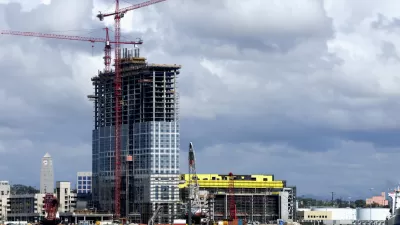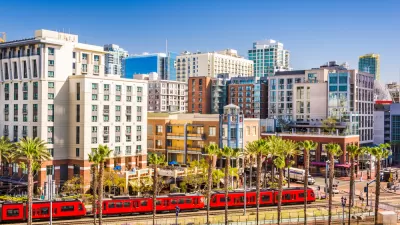When first announced in 2014, the Morena Corridor Specific Plan provoked protests. The plan has changed, but it now finally has initial approval from the San Diego City Council.
"The San Diego City Council tentatively approved two plans Thursday to let housing developers build more than 9,000 units near transit stations in Pacific Beach, Clairemont Mesa and Linda Vista," according to a city news service announcement published on August 1, 2019.
Prior to the vote, Andrew Keatts reported on the Morena Corridor Specific Plan, which had a long route to this benchmark moment.
"Five years, two City Council races and three planning directors later, San Diego is poised to make way for new homes near the largest transit investment it’s ever made," according Keatts. The plan also overcame a "fierce and well-organized neighborhood opposition" to reach this point.
Keatts summarizes the plan, which is intended to integrate land use density with the new Mid-Coast Trolley line coming to the city:
The city’s proposal would let developers build some 6,000 new homes near a new trolley station at Morena Boulevard and Tecolote Drive, and would rebuild the suburban, big box retail plots with a classic urban street grid. The Council will also decide whether to make way for 3,500 new homes at the planned station near Balboa Drive and Morena Boulevard, but only on the western side of I-5, in Pacific Beach. The city’s plan would also narrow Morena Bouelvard from four lanes to three while making way for new protected bike lanes and an improved pedestrian way along the commercial corridor.
FULL STORY: Council to Weigh Morena Plan That’s Become a Proxy for Growth Citywide

Alabama: Trump Terminates Settlements for Black Communities Harmed By Raw Sewage
Trump deemed the landmark civil rights agreement “illegal DEI and environmental justice policy.”

Planetizen Federal Action Tracker
A weekly monitor of how Trump’s orders and actions are impacting planners and planning in America.

The 120 Year Old Tiny Home Villages That Sheltered San Francisco’s Earthquake Refugees
More than a century ago, San Francisco mobilized to house thousands of residents displaced by the 1906 earthquake. Could their strategy offer a model for the present?

In Both Crashes and Crime, Public Transportation is Far Safer than Driving
Contrary to popular assumptions, public transportation has far lower crash and crime rates than automobile travel. For safer communities, improve and encourage transit travel.

Report: Zoning Reforms Should Complement Nashville’s Ambitious Transit Plan
Without reform, restrictive zoning codes will limit the impact of the city’s planned transit expansion and could exclude some of the residents who depend on transit the most.

Judge Orders Release of Frozen IRA, IIJA Funding
The decision is a victory for environmental groups who charged that freezing funds for critical infrastructure and disaster response programs caused “real and irreparable harm” to communities.
Urban Design for Planners 1: Software Tools
This six-course series explores essential urban design concepts using open source software and equips planners with the tools they need to participate fully in the urban design process.
Planning for Universal Design
Learn the tools for implementing Universal Design in planning regulations.
Clanton & Associates, Inc.
Jessamine County Fiscal Court
Institute for Housing and Urban Development Studies (IHS)
City of Grandview
Harvard GSD Executive Education
Toledo-Lucas County Plan Commissions
Salt Lake City
NYU Wagner Graduate School of Public Service




























